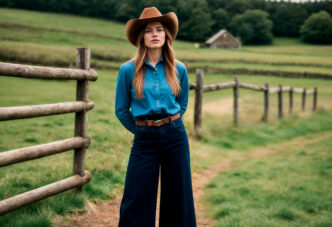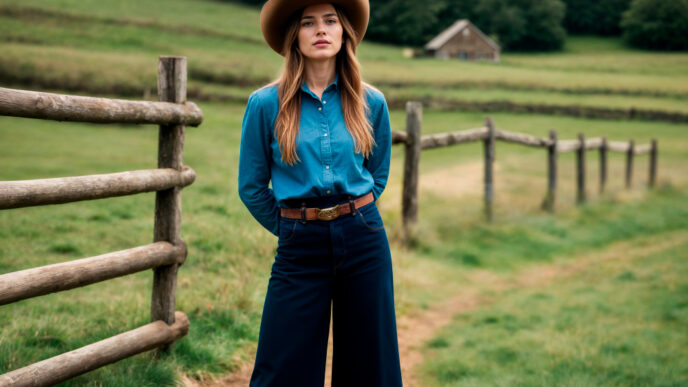Beanies have become essential accessories that blend warmth with modern fashion sensibility. These versatile pieces transform simple outfits into stylish looks while providing practical cold-weather protection. This guide explores how to style beanies across different occasions and seasons. From casual weekend wear to elevated winter outfits, beanies offer countless styling possibilities for contemporary women. Understanding proper techniques helps you incorporate these accessories into your wardrobe with confidence and flair.
Top 10 Beanie Outfit Ideas
Creating stylish combinations with beanies requires understanding how these accessories complement different clothing pieces and occasions. These outfit ideas showcase the versatility of beanies while providing practical inspiration for various settings.
Beanies with Oversized Sweaters
Pairing beanies with oversized sweaters creates cozy, comfortable looks perfect for chilly days. This combination emphasizes texture and layering while maintaining warmth and style. Choose beanies in colors that complement your sweater without matching exactly. Neutral tones work well with patterned sweaters, while colored beanies add interest to solid pieces. The oversized sweater provides a relaxed silhouette that balances the snug fit of the beanie. Add skinny jeans or leggings to create proportional contrast against the voluminous top. Complete with ankle boots or sneakers depending on the occasion. This styling works particularly well for weekend activities, casual coffee dates, or relaxed work environments. Layer with scarves for extra warmth or leave the neckline clean for simpler looks. The key lies in choosing beanies that complement rather than compete with the sweater’s texture and color palette.
Beanies with Denim Jackets
Combining beanies with denim jackets creates effortlessly cool looks that work across multiple seasons. This pairing bridges casual and edgy styling while providing practical layering options. Choose beanies in contrasting colors to create visual interest against the denim. Black, gray, or burgundy beanies work particularly well with classic blue denim. The structured nature of denim jackets provides nice contrast against the soft, rounded shape of beanies. Add basic tees or lightweight sweaters underneath for comfortable layering. Complete with jeans in different washes or pair with skirts for varied styling approaches. This combination works well for outdoor activities, casual social events, or transitional weather when full coats feel too heavy. Roll up jacket sleeves to create more relaxed vibes or wear fully buttoned for structured looks. The versatility of this pairing makes it suitable for various age groups and style preferences.
Beanies with Leather Jackets
Leather jackets paired with beanies create edgy, urban looks that exude confidence and attitude. This combination works particularly well for women who want to incorporate tougher elements into their cold-weather styling. Choose beanies in colors that complement the leather without creating harsh contrasts. Black, charcoal, or deep jewel tones work beautifully with most leather jacket colors. The contrast between the soft beanie texture and hard leather creates visual interest. Layer over fitted tops or lightweight sweaters for warmth without bulk. Add dark jeans or leather pants to maintain the edgy aesthetic. Complete with ankle boots or combat boots for cohesive styling. This look works well for concerts, evening social events, or occasions where you want to make a statement. The combination translates well from day to night with simple accessory changes. Consider the beanie’s fit carefully to ensure it complements the jacket’s structured silhouette.
Beanies with Long Coats
Long coats provide elegant backdrops for beanie styling, creating sophisticated cold-weather looks. This pairing works particularly well for professional settings and formal occasions where warmth and style must coexist. Choose beanies in colors that coordinate with your coat without being too matchy. Subtle textures like cashmere or wool beanies complement the formality of long coats beautifully. The length of the coat creates vertical lines that elongate the silhouette, while the beanie adds a contemporary touch. Layer with sweaters, blouses, or dresses underneath depending on the occasion. Add tall boots to maintain the coat’s elegant proportions. This styling approach works well for commuting, professional events, or upscale social occasions. Consider the coat’s collar style when selecting beanie fits to ensure harmonious proportions. Neutral colors provide the most versatility for professional settings, while bolder colors can add personality to weekend looks.
Beanies with Casual Dresses
Pairing beanies with casual dresses creates interesting juxtapositions that feel both feminine and practical. This combination works particularly well for transitional weather when dresses alone might not provide adequate warmth. Choose beanies that complement the dress’s color palette and style aesthetic. Knit dresses work particularly well with textured beanies, while cotton dresses pair nicely with simpler styles. The contrast between the dress’s feminine silhouette and the beanie’s casual nature creates modern, approachable looks. Add tights or leggings for extra warmth and coverage. Complete with ankle boots, knee boots, or even sneakers depending on the dress style and occasion. Layer with cardigans, blazers, or light jackets as needed. This styling approach works well for casual work environments, weekend outings, or social events where comfort and style intersect. The key lies in selecting beanies that enhance rather than overpower the dress’s inherent femininity.
Beanies with Athleisure Wear
Athletic-inspired outfits pair naturally with beanies, creating comfortable, contemporary looks perfect for active lifestyles. This combination emphasizes function while maintaining modern style sensibility. Choose beanies in performance fabrics or moisture-wicking materials for actual athletic activities. The casual nature of athleisure wear complements the relaxed vibe of beanies perfectly. Pair with leggings, joggers, or athletic shorts depending on the season and activity level. Add performance tops, hoodies, or lightweight jackets for layering versatility. Complete with sneakers or athletic shoes for cohesive styling. This look works well for gym sessions, outdoor activities, running errands, or casual social occasions. The comfort factor makes this combination popular among women with active lifestyles. Consider beanies with reflective elements for early morning or evening outdoor activities. The key lies in selecting pieces that work together functionally while maintaining style consciousness.
Beanies with Blazers
Combining beanies with blazers creates unexpected style contrasts that feel both professional and contemporary. This pairing works particularly well in creative work environments where personality expression is valued alongside professionalism. Choose beanies in sophisticated colors and textures that complement the blazer’s formality level. Wool or cashmere beanies work better than casual knits for professional settings. The structured nature of blazers provides interesting contrast against the soft, casual nature of beanies. Layer over blouses, sweaters, or fitted tops depending on the occasion. Add tailored pants or skirts to maintain professional proportions. Complete with dress shoes or ankle boots appropriate for the setting. This styling approach works well for creative industries, casual Fridays, or professional events with relaxed dress codes. The combination bridges the gap between formal and casual styling effectively. Consider the blazer’s lapel style when selecting beanie fits to ensure proportional harmony.
Beanies with Scarves
Layering beanies with scarves creates maximum warmth while offering numerous styling possibilities. This combination works particularly well during harsh winter weather when both accessories serve practical purposes. Choose pieces in complementary colors or coordinating patterns to create cohesive looks. The textures of both accessories can either match for unified appearances or contrast for visual interest. Infinity scarves work particularly well with beanies, creating clean lines without bulk. Traditional scarves offer more styling versatility but require careful arrangement to avoid overwhelming the beanie. This pairing works with virtually any outerwear from casual jackets to formal coats. The key lies in balancing proportions so neither accessory overwhelms the other. Consider the beanie’s fit when adding scarves to ensure comfortable layering without excessive bulk around the neck and head area. This combination provides maximum cold-weather protection while maintaining style consciousness.
Beanies with Hoodies
Pairing beanies with hoodies creates ultra-casual, comfortable looks perfect for relaxed occasions. This combination emphasizes comfort while maintaining contemporary style sensibility. Choose beanies in colors that either complement or contrast with the hoodie depending on your desired aesthetic. The double head coverage creates interesting layering effects while providing maximum warmth. Layer the beanie over the hoodie or wear the hood down depending on weather conditions and style preferences. This combination works particularly well for outdoor activities, casual social events, or lounging occasions. Add jeans, leggings, or comfortable pants to complete the relaxed look. Complete with sneakers or casual boots for cohesive styling. The comfort factor makes this pairing popular among younger demographics and casual dress environments. Consider the hoodie’s fit when selecting beanies to ensure comfortable layering without excessive bulk.
Beanies with Statement Coats
Bold, statement coats provide dramatic backdrops for strategic beanie styling. This combination allows the coat to serve as the outfit’s focal point while the beanie adds complementary warmth and texture. Choose beanies in neutral colors that don’t compete with the coat’s statement elements. The beanie should enhance rather than detract from the coat’s dramatic impact. This pairing works particularly well for special occasions, evening events, or situations where making a fashion statement is desired. Layer with simple pieces underneath to let the coat remain the primary focus. Add boots or heels appropriate for the occasion and coat’s formality level. This styling approach works well for fashion-conscious women who want to incorporate practical accessories without compromising dramatic impact. The key lies in selecting beanies that complement the coat’s color palette and overall aesthetic without competing for visual attention.
Types and Styles of Beanies
Understanding different types of beanies for women helps in making informed choices that suit your face shape, hair type, and personal style preferences. Classic knit beanies represent the most versatile category, featuring traditional ribbed or cable-knit patterns that work across multiple occasions and outfits. These timeless pieces typically offer moderate stretch and comfortable fit while providing reliable warmth. The neutral nature of classic knits makes them excellent wardrobe investments that coordinate with various clothing styles and color palettes.
Slouchy beanies feature relaxed, oversized fits that create casual, effortless vibes. These styles work particularly well for women with longer hair who need extra room or those who prefer looser-fitting accessories. The excess fabric creates interesting draping effects that add visual texture to outfits. Slouchy styles often work better with casual clothing than formal pieces due to their relaxed aesthetic. The additional fabric provides extra warmth while creating contemporary silhouettes that appeal to various age groups.
Cuffed beanies incorporate folded brims that add structure and visual weight to the accessory. These styles offer versatility through adjustable cuff positioning that can modify the beanie’s overall appearance and fit. The cuff detail adds textural interest while providing extra insulation around the ears. These pieces work well with both casual and slightly more polished outfits depending on the fabric and color selection. The structured nature of cuffed styles makes them suitable for professional casual environments.
Fitted beanies offer snug, streamlined silhouettes that work particularly well for women with shorter hair or those who prefer minimal bulk. These styles create clean lines that complement tailored outfits and formal coats. The close fit ensures the beanie stays in place during active wear while maintaining neat appearances. Fitted styles work particularly well in professional settings where polished appearance is important. The streamlined nature makes them excellent choices for layering under hoods or helmets.
Pom-pom beanies feature decorative elements that add playful, youthful energy to winter outfits. These details create visual interest while maintaining practical warmth. The pom-pom size and material significantly impact the beanie’s overall aesthetic and appropriateness for different occasions. Smaller, subtle pom-poms work better for professional settings, while larger, colorful versions suit casual and recreational wear. These styles often appeal to women who want to add personality to their cold-weather accessories.
Textured beanies incorporate cable knits, seed stitches, or other decorative patterns that create visual and tactile interest. These pieces serve as accessories that add dimension to simple outfits while providing warmth. The texture variations catch light differently, creating dynamic appearances that change throughout the day. These styles work particularly well with solid-colored outfits where the beanie can serve as a textural focal point. The craftsmanship involved in textured pieces often justifies higher price points.
Cashmere and luxury fiber beanies offer superior softness and warmth while maintaining elegant appearances suitable for formal occasions. These pieces typically feature refined constructions and subtle colors that complement professional and upscale casual outfits. The investment in quality materials often results in longer-lasting accessories that maintain their appearance over time. These styles work particularly well for women who prioritize comfort and luxury in their accessories.
Color and pattern variations significantly impact beanie versatility and styling options. Neutral colors like black, gray, navy, and camel provide maximum coordination possibilities with existing wardrobes. Bold colors add personality and seasonal interest but may limit outfit coordination options. Patterns and prints require careful consideration to ensure they complement rather than compete with outfit elements. Understanding how different colors and patterns work with your complexion and wardrobe helps in making strategic beanie selections.
How To Choose The Best Beanie
Selecting the perfect beanie requires evaluating several key factors that ensure both comfort and style suitability. Start by determining your head size and preferred fit level, as beanies come in various sizes and stretch levels. Measure your head circumference just above your eyebrows and ears to understand your size requirements. Consider whether you prefer snug fits that stay in place during activity or looser fits that provide comfortable wear for extended periods.
Evaluate your face shape to select beanie styles that complement your natural features. Round faces benefit from beanies with height that elongate the silhouette, while angular faces work well with softer, slouchy styles that add curves. Oval faces can wear most beanie styles successfully, while heart-shaped faces benefit from styles that add width at the jawline. Understanding these relationships helps in making flattering selections.
Consider your hair type and typical styling when selecting beanie fits and styles. Women with thick or curly hair may need looser fits or slouchy styles that accommodate volume. Those with fine or short hair can wear fitted styles more easily. Consider how the beanie will affect your hairstyle and whether you’re comfortable with hat hair or need styles that minimize hair disruption.
Assess the quality of materials and construction before making purchases. Higher-quality fibers typically provide better warmth, durability, and appearance retention over time. Examine seam construction, fabric density, and finishing details that indicate overall quality. Consider care requirements and whether they align with your lifestyle and maintenance preferences.
Think about your intended use and styling needs when selecting beanie styles. Casual wear requires different considerations than professional or formal occasions. Consider climate conditions, activity levels, and wardrobe coordination needs when making selections. Understanding how different styles work with your existing clothing helps ensure successful integration into your wardrobe.
Seasonal Style Guide for Beanies
Fall represents the beginning of beanie season when these accessories provide transitional warmth and style. Choose lightweight beanies in seasonal colors like burgundy, forest green, or warm brown that complement autumn’s palette. Layer over light sweaters, cardigans, or jackets that provide moderate warmth without bulk. The moderate temperatures allow for creative layering that showcases both the beanie and underlying pieces. Add ankle boots, loafers, or casual shoes appropriate for fall activities. This season works well for introducing beanies gradually into your wardrobe rotation.
Winter demands maximum warmth and weather protection from beanie selections. Choose thicker, more insulating materials like wool or cashmere that provide serious cold-weather protection. Layer with heavy coats, parkas, or winter jackets that accommodate the beanie’s bulk comfortably. The harsh weather conditions make practical considerations as important as style elements. Add winter boots, warm accessories, and protective outerwear for complete cold-weather dressing. Focus on darker colors and durable materials that withstand harsh weather conditions while maintaining appearance.
Spring allows for transitional beanie styling as weather moderates and layering becomes lighter. Choose breathable materials in fresh colors that celebrate the season’s renewal energy. Layer with light jackets, cardigans, or blazers that can be removed as temperatures rise throughout the day. The variable spring weather makes adaptable layering essential for comfort and style. Add lighter footwear like sneakers, ballet flats, or low boots appropriate for spring activities. This season offers opportunities to experiment with brighter colors and lighter textures.
Summer typically sees reduced beanie wear except for air-conditioned environments or evening temperature drops. Choose the lightest possible materials in neutral colors that won’t overwhelm summer outfits. Focus on minimal styling that adds texture without excessive warmth. The limited summer beanie wearing makes quality over quantity particularly important for seasonal selections. Consider travel destinations or activities where beanies might provide practical benefits despite warm weather.
Do’s and Don’ts of Wearing Beanies
Understanding proper beanie etiquette ensures you look polished and appropriate regardless of the setting or occasion. Do consider the appropriateness of beanie wear for different environments and social situations. While beanies work well for casual settings, they may not suit formal business meetings, elegant dinner parties, or other upscale occasions where more refined headwear or no hat at all is expected. Understanding social contexts helps you make appropriate accessory choices.
Do pay attention to how beanies affect your hairstyle and overall grooming appearance. Remove beanies when entering buildings, dining, or during important conversations as a sign of respect and social awareness. Plan your hairstyle around beanie wear, considering how the accessory will affect your hair’s appearance when removed. Keep styling tools handy for quick hair adjustments after beanie removal.
Do invest in quality beanies that maintain their shape, color, and appearance over time. Cheap alternatives often lose their form, pill excessively, or fade quickly, making them poor long-term investments. Quality pieces provide consistent comfort and appearance that justify their higher initial costs. Consider cost-per-wear when evaluating beanie purchases, focusing on versatile pieces that work with multiple outfits.
Don’t ignore fit and proportion when selecting and wearing beanies. Overly tight beanies create unflattering pressure marks and discomfort, while excessively loose styles may slip or look sloppy. Find the balance that provides comfortable wear while maintaining intended style effects. Consider how different fits work with your face shape and personal aesthetic preferences.
Don’t overlook care and maintenance requirements that keep beanies looking their best. Follow washing instructions carefully to prevent shrinkage, color loss, or texture damage. Store beanies properly to maintain their shape between seasons. Address stains or odors promptly to prevent permanent damage. Regular care extends the life and appearance of quality beanies significantly.
Don’t wear beanies that send inappropriate messages or contain offensive graphics, especially in professional or mixed social settings. Choose pieces that reflect your personal style while maintaining respect for others and social appropriateness. Consider how others might interpret your accessory choices in different contexts.
Don’t forget to coordinate beanie colors and styles with your overall outfit aesthetic. Mismatched or clashing accessories can detract from otherwise stylish outfits. Consider color theory, style consistency, and proportional balance when incorporating beanies into your looks. Practice different combinations to understand which pairings work best for your wardrobe and personal style.
8 Tips on How to Wear Beanies
These essential tips help you maximize beanie styling potential while maintaining comfort and appropriateness across various occasions. First, master the art of positioning beanies on your head for the most flattering appearance. The beanie should sit comfortably above your eyebrows without pulling them down or creating unflattering shadows around your eyes. Avoid pushing beanies too far back on your head, as this can create unflattering proportions and affect the accessory’s practical warmth benefits.
Second, consider your ear coverage preferences when selecting and positioning beanies. Some styles are designed to cover ears completely for maximum warmth, while others work better when positioned higher for style purposes. Understanding how different positions affect both appearance and comfort helps you make appropriate choices for different weather conditions and occasions.
Third, learn to coordinate beanie colors strategically with your outfits for maximum visual impact. Neutral colors like black, gray, and navy provide versatile coordination options, while bold colors can serve as outfit focal points. Consider your complexion when selecting colors, choosing shades that complement your skin tone and enhance your natural features. Develop a small collection of versatile colors that work with your existing wardrobe.
Fourth, practice removing and replacing beanies gracefully to minimize hair disruption and maintain polished appearances. Develop techniques for quick hair adjustments after beanie removal, keeping styling tools accessible when necessary. Consider protective hairstyles that work well under beanies and recover quickly when the accessory is removed.
Fifth, understand how different beanie styles work with various hair lengths and textures. Long hair may require looser fits or specific positioning to accommodate volume comfortably. Short hair often works well with fitted styles that create clean silhouettes. Curly or textured hair may benefit from satin-lined beanies that reduce friction and frizz.
Sixth, consider seasonal appropriateness when selecting beanie weights and materials. Heavy wool beanies work well for harsh winter conditions but may be uncomfortable in milder weather. Lighter cotton or bamboo blends provide comfort for transitional seasons or air-conditioned environments. Match your beanie selection to actual weather conditions and activity levels.
Seventh, develop signature styling approaches that reflect your personal aesthetic and lifestyle needs. Some women prefer minimal, classic approaches, while others enjoy bold, statement-making beanie styling. Understanding your preferences helps you make consistent choices that build a cohesive personal style. Document successful combinations for future reference and continued development.
Eighth, maintain beanie hygiene and freshness through regular cleaning and proper storage. Wash beanies according to care instructions to prevent odor buildup and maintain appearance. Store properly to prevent stretching, pilling, or damage between wears. Address any issues promptly to extend the life and wearability of your beanie collection.
Best Alternatives to Beanies
Baseball caps offer practical head coverage while providing different aesthetic appeals than beanies. These structured accessories work well for casual occasions and active wear where beanies might feel too warm or bulky. Choose caps in neutral colors for versatility or team logos for personal expression. Style with athleisure wear, casual outfits, or outdoor activity clothing. The brim provides sun protection that beanies cannot offer, making caps practical for transitional weather.
Headbands provide minimal head coverage while adding style elements to winter outfits. These accessories work particularly well for women who want hair protection without full head coverage. Choose knit or fleece materials for cold weather warmth. Style with outerwear that provides adequate head warmth or use headbands for transitional weather. The minimal coverage works well for maintaining hairstyles while adding winter accessory elements.
Scarves wrapped around the head create vintage-inspired looks while providing warmth and coverage. This styling technique offers versatility through different wrapping methods and scarf selections. Choose lightweight materials for style purposes or heavier fabrics for actual warmth. This alternative works well for women who want unique head covering options or those avoiding traditional hat styles. The technique requires practice but offers creative styling possibilities.
Ear warmers provide targeted warmth without full head coverage, working well for women who want practical warmth while maintaining hairstyles. These accessories focus protection on the most vulnerable areas while leaving hair visible. Choose materials that coordinate with outerwear and personal style preferences. Style with various outfits where full beanies might feel excessive but ear protection is needed.
Conclusion
Mastering beanie styling transforms these practical accessories into versatile fashion elements that enhance cold-weather wardrobes. The key lies in understanding fit, proportion, and coordination principles that create polished looks while maintaining comfort and warmth. From casual weekend styling to professional environments, beanies offer numerous possibilities for personal expression and practical function.
Building a thoughtful collection of quality beanies ensures you have appropriate options for various weather conditions and occasions. Focus on versatile pieces that coordinate with your existing wardrobe while reflecting your personal aesthetic preferences. Remember that successful beanie styling comes from confidence and understanding how these accessories complement your individual features and lifestyle needs.
With proper selection, care, and styling techniques, beanies serve as valuable wardrobe investments that provide consistent comfort and style throughout cold weather seasons. Whether you prefer classic neutral pieces or bold statement accessories, understanding these principles helps you incorporate beanies successfully into your personal style repertoire.













